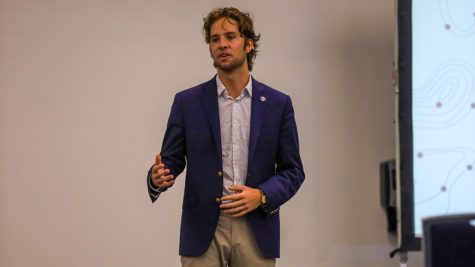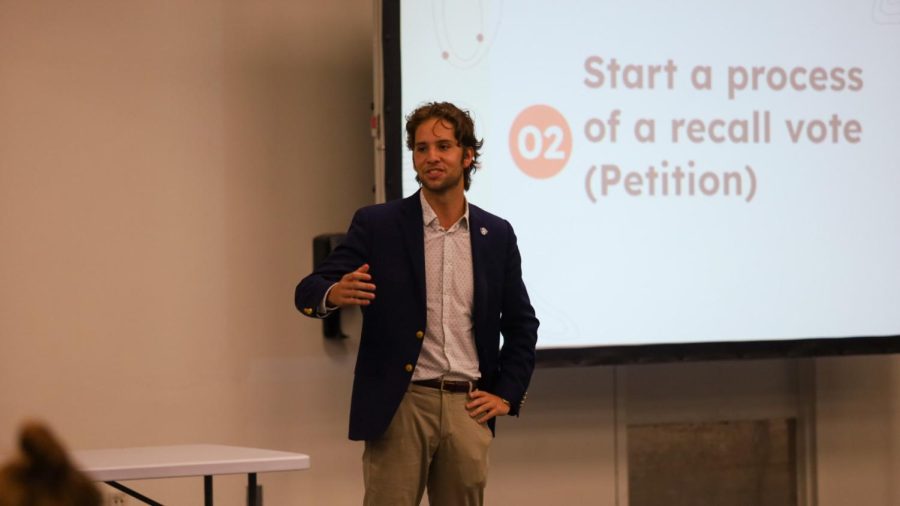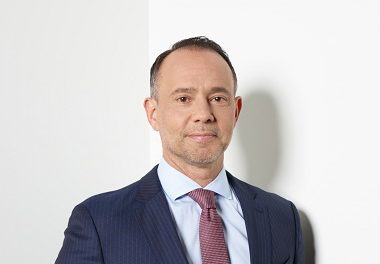‘I’m not racist’: Student body president downplays his controversial TikTok
Diversity groups were outraged not only at his TikTok, but by his explanation as to why they viewed it as insensitive.
The student body president attended a meeting last night that was meant to discuss how to hold him accountable. Instead, he stood at the front and answered student questions.
October 7, 2021
Five student diversity groups met Wednesday night to decide if they would call for the resignation of student body president Max Simonson, after they expressed outrage at a since-deleted TikTok he made earlier this year. Instead, Simonson showed up uninvited, and those groups have decided to meet again this week – in secret so Simonson can’t find them.
Joi Dean, co-president of FAU’s chapter of the National Organization for Women, asked Simonson if he wanted to make a statement before the meeting. Simonson did want to comment – he spoke for 45 minutes, taking questions from the audience.

He started by informing the crowd that he wrote a formal statement about the TikTok, but that it cannot be posted to social media until university officials approve it.
“I accept responsibility and understand it was insensitive,” Simonson said. “It is in no way representative of my character. I’m not racist.”
A crowd member asked the student body president why he didn’t acknowledge the TikTok back in February when he deleted it. Simonson, who removed the video after meeting with SG Adviser Donald Van Pelt, said it wasn’t a big deal then.
“It didn’t seem like a big enough problem back then,” he said. “Now it is and I’m addressing it.”

Simonson stated several times that he is Mexican and Native American, which did not appease the crowd as they felt he was using his heritage as an excuse for his actions.
“You seem to think being Mexican and Native American excuses what you did,” FAU NOW member Paul Leachman said. “But it doesn’t.”
Simonson denied that he used his heritage as a justification for the TikTok, which caused the crowd to audibly groan.
“I personally am a minority,” he said. “You guys don’t know me. My friends are minorities.”
When asked how he learned from his mistake, Simonson stated that he visits and works with the Morikami Museum and Japanese Gardens in Delray Beach.

One student asked Simonson to explain why many in the campus community feel the video is insensitive.
“Because it’s stereotypes. It’s making fun of the Chinese government,” Simonson said, which received murmurs from the crowd.
Students felt that Simonson did not fully understand why they found his TikTok to be harmful.
“Stereotypes kill,” Rafaela St. Juste, FAU NOW director of programming, said. “That’s what we want you to know.”
The Asian Student Union offered to educate Simonson on why the video was harmful if he wanted to learn. He accepted and said he would bring his friends as well.
Simonson stated that he had tried to work with the organization but ASU representatives said they had no record of it, which gathered audible gasps from the crowd.
“I learned from it and won’t do it again,” Simonson said about the TikTok. “I’ve grown from it. We need to make our mistakes now. I’m a changed man.
As of now, the student organizations at the meeting have not decided how they want to hold Simonson accountable.
The organizations that attended the meeting were:
- Asian Student Union (ASU)
- Black Student Union (BSU)
- The National Association for the Advancement of Colored People (NAACP)
- National Organization for Women (NOW)
- Students for Peace
They will hold another meeting in coming days to discuss the possibility of petitioning for the student body president’s removal.
According to the student government constitution, if a petition for the student body president’s removal receives 10% of the student body’s signatures, approx. 3,000, the university will hold a vote. If the majority of the student body votes for Simonson’s removal, he will no longer be in office.
Kendall Little is the Managing Editor for the University Press. For more information regarding this or other stories, email [email protected] or tweet her @klittlewrites.

















Yeve • Oct 26, 2021 at 8:28 am
I wish there was a description of the TikTok video that was deleted, so that we would know what people are mad about.